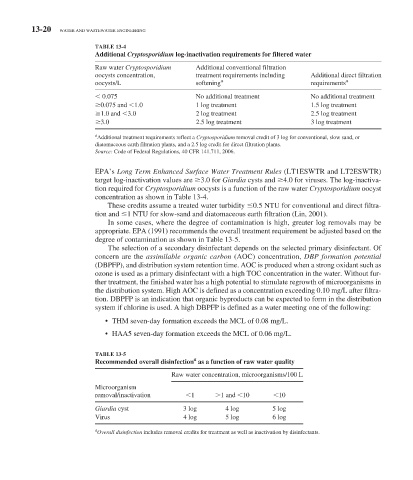Page 525 - Water and wastewater engineering
P. 525
13-20 WATER AND WASTEWATER ENGINEERING
TABLE 13-4
Additional Cryptosporidium log-inactivation requirements for filtered water
Raw water Cryptosporidium Additional conventional filtration
oocysts concentration, treatment requirements including Additional direct filtration
oocysts/L softening a requirements a
0.075 No additional treatment No additional treatment
0.075 and 1.0 1 log treatment 1.5 log treatment
1.0 and 3.0 2 log treatment 2.5 log treatment
3.0 2.5 log treatment 3 log treatment
a
Additional treatment requirements reflect a Cryptosporidium removal credit of 3 log for conventional, slow sand, or
diatomaceous earth filtration plants, and a 2.5 log credit for direct filtration plants.
Source: Code of Federal Regulations, 40 CFR 141.711, 2006.
EPA’s Long Term Enhanced Surface Water Treatment Rules (LT1ESWTR and LT2ESWTR)
target log-inactivation values are 3.0 for Giardia cysts and 4.0 for viruses. The log-inactiva-
tion required for Cryptosporidium oocysts is a function of the raw water Cryptosporidium oocyst
concentration as shown in Table 13-4 .
These credits assume a treated water turbidity 0.5 NTU for conventional and direct filtra-
tion and 1 NTU for slow-sand and diatomaceous earth filtration (Lin, 2001).
In some cases, where the degree of contamination is high, greater log removals may be
appropriate. EPA (1991) recommends the overall treatment requirement be adjusted based on the
degree of contamination as shown in Table 13-5 .
The selection of a secondary disinfectant depends on the selected primary disinfectant. Of
concern are the assimilable organic carbon (AOC) concentration, DBP formation potential
(DBPFP), and distribution system retention time. AOC is produced when a strong oxidant such as
ozone is used as a primary disinfectant with a high TOC concentration in the water. Without fur-
ther treatment, the finished water has a high potential to stimulate regrowth of microorganisms in
the distribution system. High AOC is defined as a concentration exceeding 0.10 mg/L after filtra-
tion. DBPFP is an indication that organic byproducts can be expected to form in the distribution
system if chlorine is used. A high DBPFP is defined as a water meeting one of the following:
• THM seven-day formation exceeds the MCL of 0.08 mg/L.
• HAA5 seven-day formation exceeds the MCL of 0.06 mg/L.
TABLE 13-5
a
Recommended overall disinfection as a function of raw water quality
Raw water concentration, microorganisms/100 L
Microorganism
removal/inactivation 1 1 and 10 10
Giardia cyst 3 log 4 log 5 log
Virus 4 log 5 log 6 log
a
Overall disinfection includes removal credits for treatment as well as inactivation by disinfectants.

